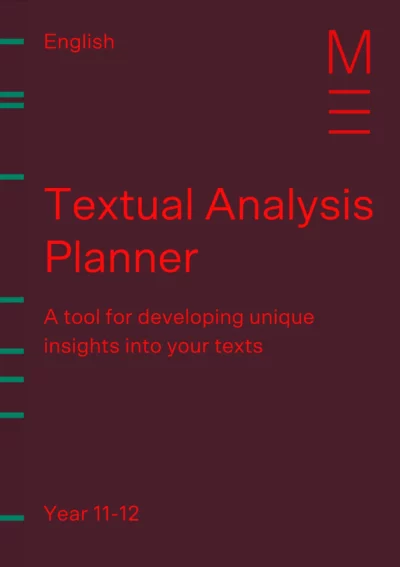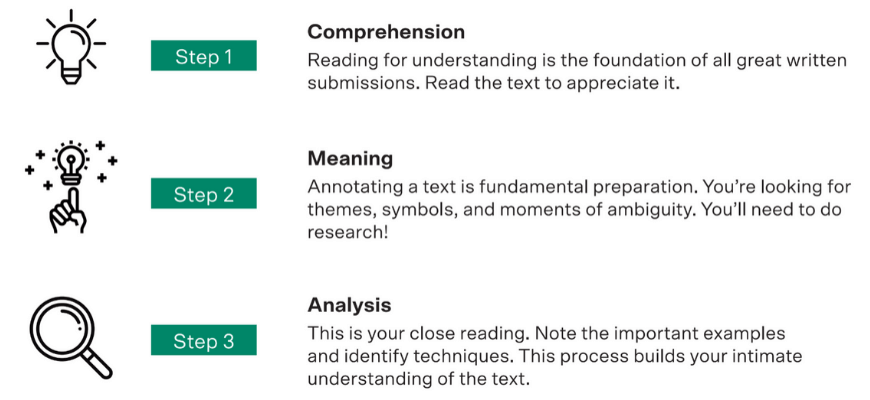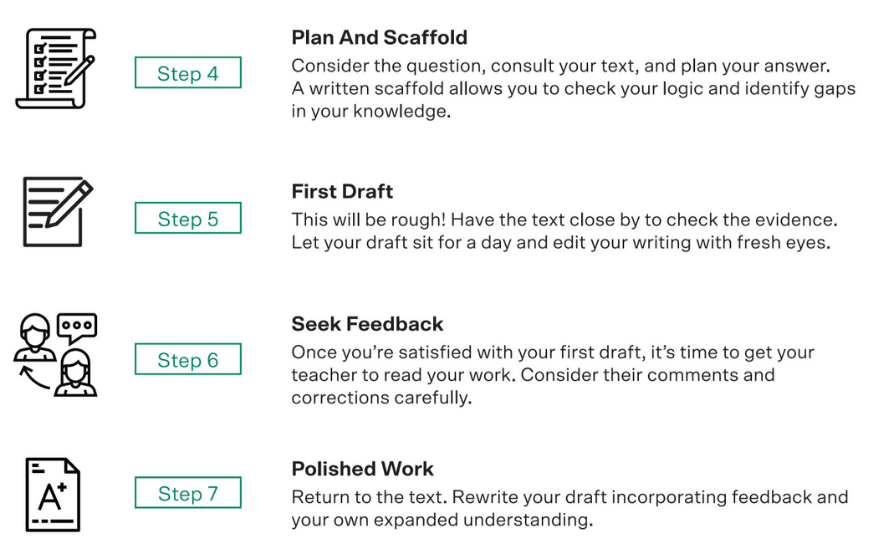Welcome to Matrix Education
To ensure we are showing you the most relevant content, please select your location below.
Select a year to see courses
Learn online or on-campus during the term or school holidays
Learn online or on-campus during the term or school holidays
Learn online or on-campus during the term or school holidays
Learn online or on-campus during the term or school holidays
Learn online or on-campus during the term or school holidays
Learn online or on-campus during the term or school holidays
Learn online or on-campus during the term or school holidays
Get HSC exam ready in just a week
Select a year to see available courses
Science guides to help you get ahead
Science guides to help you get ahead

Guide Chapters
Why analyse texts? Textual Analysis in Year 9 requires you to really peel back the superficial layer of a text and look at what the composer is representing and how.

Level up how you analyse texts and take notes with expert strategies and templates!

Fill out your details below to get this resource emailed to you.
"*" indicates required fields
The further you get into high school, the more you will notice that the focus is on pulling apart chunks of the text, rather than recounting events or describing moments. Unpacking texts in this way helps us understand what composers are trying to say about the human experience as well as teaching us how they construct their texts.
In this article, we’re going to explain what textual analysis is in Year 9. Then, in the subsequent articles, we’ll give you step-by-step guides for analysing a variety of text types that you’ll encounter in Year 9.
Textual analysis is the process of reading a text to understand the meaning of a text AND how that meaning is being conveyed.
When we engage in textual analysis, there are many different ways that we can read for meaning. The common forms of textual analysis you will encounter in school are:
In junior years, Stage 4 and below, students tend to focus on plot and characters. In Stage 5 and beyond, the focus shifts and broadens.
From Year 9 onwards, you will need to really dig into the text and think about these deeper and more complex concerns.
The NSW Department of Education defines the key steps in textual analysis as:
When students are trying to connect and engage with a text, they need to start thinking about how composers are using figurative devices – things like metaphors and similes in written texts or mise en scene and shot types or sound in visual texts and film – to create meaning for audiences.

What you will focus on in Year 9 will prepare for you for more challenging analysis in year 10.
In Year 9, you need to:
In Year 10, and even later in Year 9, you will have to start considering more complex concepts about texts in your analysis:
If you feel you need to to know about those now, read our article in the Beginner’s Guide to Year 10 English: Textual Analysis in year 10.
The process of textual analysis is crucial for Stage 5.
During Stage 5, students like you are expected to increase your understanding of texts and various types of texts. The idea is that as you look at more texts with increasing detail, you will develop your understanding of texts. This will provide you with the tools to explain ideas, infer new information, speculate about new ideas, and problem solve.
When we discuss textual analysis, many students don’t think of it as a process.
It’s quite common for students to see textual analysis as a vague thing they do to understand texts.
But the truth is, if you want to ace English, you need to be process driven in your approach to analysing texts. At Matrix, students learn how to follow the Matrix MethodTM for analysing and writing texts.
In the following Guides, we will step you through the following process:
This process is designed to help you crystalise your understanding of a text before you start writing about it. This will allow you to produce a more refined and insightful response.
In the next 6 guides, we will walk you through the step-by-step process – Steps 1-3 – for analysing a variety of different text types to develop your understanding of the text.

We will then take you through Steps 4-7, the process of composing a variety of different responses – from planning to drafting and, finally, submitting a polished piece of work.

The first three steps of the Matrix method are all about developing your UNDERSTANDING and engaging with your texts. Each of these steps includes a reading or viewing of your text.
Yes! This means that you must read or view your text at least three times. This will help you get a comprehensive understanding of your text.
Before we walk you through the comprehension part of the Matrix Method, let’s look at why it has helped so many students conquer their English struggles.
Understanding a text should help you comprehend:
But, understanding doesn’t just happen.
Reading or watching an English text once is not going to give you the information you need to nail your assessments.
Far from it, a singular reading will only give you a cursory understanding of the text. Why?
When you read a text the first time you get a sense of what the text is about and who the characters in it are. Trying to analyse a text while you read it the first time will make it harder to get a holistic sense of it. Going back and reading it a second time will allow you to pick about how those ideas, the plot, and character are developed. The second reading allows you to evaluate each moment in the text in light of the whole text.
The second reading is about building on an understanding of a text and thinking about how it has been constructed to produce meaning. The best way to gain this insight is by following a process.
Why?
Using a process to analyse a text forces you to be systematic about reading, analysing, AND taking notes.
Once students follow the process, they see their analysis deepen, their responses become more insightful, and their marks improve:
 Let’s look at the process of understanding texts:
Let’s look at the process of understanding texts:
As you engage in your second reading, you should begin making notes and annotating your text.
If you find something interesting, write it down! Make note of your initial thoughts and insights. You must then return to these later!
Once you have understanding, you’re in a position to start a detailed analysis of the key parts of the text.

A large component of textual analysis is exploring how composers use techniques to convey meaning. This is what you should be doing in your third reading.
Once you have understanding, you can start analysing for techniques. This is when you seek to identify key moments in a text and look at how the composer has developed the meaning. You need to see what techniques they have used.
Ask yourself, have the composers employed symbols, metaphors, or used literary devices, or filmic techniques that amplify or draw attention to certain ideas or themes in the text at that moment.
Once you’ve identified techniques, you need to start thinking about how they create meaning. Ask yourself, How does this example and technique:
This is a process of close reading and comprehension that you need to practice so you can perfect it. It is essential that you write down you findings and thoughts as you go through this process.
If you are unsure of how to make notes, you should read the previous article in this Guide, How to Make Notes.
Once you have analysed your text and unpacked the key moments in the text and seen how the composer has represented these, you are ready to start thinking about meaning in a deeper way.

What do we mean when we say looking at texts in a deeper way? We mean engaging with them on a critical and personal level and connecting your knowledge of the text to external ideas and experiences.
This is a three-step process, let’s see what this involves:
When we engage with texts we start relating them to our own lives and experiences. This allows us to consider how the text we are reading or viewing compares to other texts that we have engaged with in the past.
This allows us to think about how others view or represent the world. From these experiences, we develop a wide understanding of the world and the individuals we share it with.
It is important that we think about these connections as we analyse texts. Connections you should look for between texts are:
As you ponder these connections, write down your findings and conclusions. It’s okay to not come up with concrete answers! Sometimes your analysis will leave you with more questions than answers, this is okay.
You should use these questions for thinking more broadly about human experience and the human condition.
When you engage critically, you read or view your text with a view to a particular set of ideas and beliefs.
Sometimes this gets called “a reading.” When you engage in this practice, you are trying to consider the text through a particular set of ideas or values to see how it represents them.
Some things that you may be asked to read texts for include:
Critical engagement will force you to draw upon a wide array of knowledge and research different sources. One of the difficulties students face when studying English is coming to terms with the lack of limits to what can be explored. As English is a study of art and art is a process of representing human experience, the idea that you need to have an understanding of the totality of human experience can be overwhelming and disheartening.
Rather than panicking about having to learn huge amounts of information, students should approach English as a way to gain this information.
Year 9 is a crucial year for developing the background and foundational understanding of the world to think about the more complex texts and ideas you will face in Years 11 and 12. A consistent habit of reading from a variety of genres and text types will help you develop this knowledge!

Engaging personally means more than just deciding whether you like or dislike a text.
In Year 9, it is important that you start connecting your experience of a text to your own experiences and beliefs.
When you take this approach to engaging emotionally and personally to your text you should consider:
These questions may seem broad, but asking yourself them will help you develop your understanding of the text by analysing your response to it.
You should make notes as you go through this process. Adding this information to the notes you’ve already developed as you go through the process of textual analysis will give them depth and insight.
We’ve covered quite a lot in this article. So, here is a summary of how to do each of your readings
Read or view your text at least three times.
If you need to learn about context, genre, or higher order techniques, read Part 2 of our Beginner’s Guide to Year 10 English: Textual Analysis in Year 10.
Now we’ve explained the process for textual analysis, we’re going to give you some step-by-step guides for analysing specific text types:
First up, we’re going to look at how to Analyse Prose Fiction.
© Matrix Education and www.matrix.edu.au, 2023. Unauthorised use and/or duplication of this material without express and written permission from this site’s author and/or owner is strictly prohibited. Excerpts and links may be used, provided that full and clear credit is given to Matrix Education and www.matrix.edu.au with appropriate and specific direction to the original content.